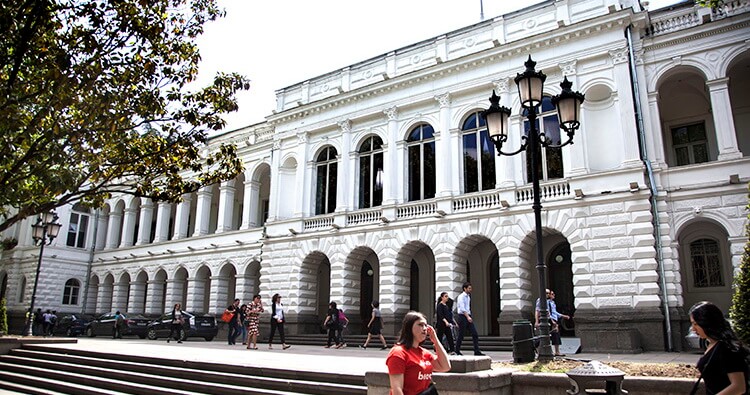Tbilisi's National Palace rehabilitation to take 2 years, cost 34 million GEL

The Municipal Development Fund will carry out the two-year work on the building. Photo: Nino Alavidze/agenda.ge.
The National Palace in central Tbilisi, an educational venue with history spanning back to the 19th century, is going under rehabilitation works that have been estimated at 34 million GEL ($10.2 mln/€8.5 mln) and are set to conclude in 2023, mayor Kakha Kaladze announced on Wednesday.
First revealed last year, plans for the repairs to the building have now gone into the high gear, with scaffolding and a safety fence getting set up around the large hall located on Rustaveli Avenue. Kaladze has called the physical condition of the building "very grave".
The mayor also said the rehabilitation would take "sensitive work" on the venue, adding "each detail [and] ornament" of the building - designated a cultural heritage monument - would receive adequate attention during the work. The facade, interior and inner yard of the site will be rehabilitated as part of the initiative.
Plans announced last year said the National Palace, previously known as The Youth Palace - and in Soviet Union years as The Pioneers' Palace - would have its walls and foundation reinforced, rooms renovated and decorative halls conserved. Doors and windows of the venue will be replaced for a "complete rehabilitation" effort.

The venue bears historic importance due to its connection to the First Democratic Republic of Georgia as well as the 19th century era of the capital city. Photo via National Palace.
Originally built in the early 19th century, the venue went under a reconstruction based on a plan by German architect Otto Simonson - known for his work on other major buildings of the Georgian capital during the era - in the middle of the century.
Located at 6, Shota Rustaveli Avenue, it was built to serve as the residence for Tsarist Russia's imperial viceroy to the Caucasus, before it became the historic venue where the independence of the First Democratic Republic of Georgia was proclaimed in 1918.
The same building became the tribune for governments of Armenia and Azerbaijan, the two other nascent modern states of the South Caucasus, to announce their break from Russian control. It was also the location of the adoption of the first Georgian constitution on February 21, 1921, just four days before invading Soviet armies ended the independence of the republic.
The National Palace currently functions as a venue for providing extra-curricular education for youth aged between 6-26, with around 4,500 students registered for classes in music, languages, folklore, theatre and more.
 Tweet
Tweet  Share
Share